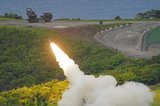US Navy's MQ-4C Triton UAV takes flight
The MQ-4C Triton unmanned aircraft vehicle (UAV) under development by Northrop Grumman for the US Navy has completed its first flight on 22 May. The 1.5 hour flight test was conducted from Northrop Grumman’s manufacturing facility in Palmdale.
As prime contractor for the programme, Northrop Grumman is developing the Triton UAV to fly surveillance missions up to 24 hours at altitudes of more than 10 miles – allowing coverage out to 2,000 nautical miles. The advanced suite of sensors can detect and automatically classify different types of ships.
Capt James Hoke, Triton program manager with Naval Air Systems Command, said: ‘First flight represents a critical step in maturing Triton's systems before operationally supporting the navy's maritime surveillance mission around the world. Replacing our aging surveillance aircraft with a system like Triton will allow us to monitor ocean areas significantly larger with greater persistence.’
Mike Mackey, Northrop Grumman Triton UAS deputy program director, added: ‘Triton is the most advanced intelligence, surveillance and reconnaissance [ISR] unmanned aircraft system ever designed for use across vast ocean areas and coastal regions. Through a cooperative effort with the navy and our industry partners, we successfully demonstrated the flight control systems that allow Triton to operate autonomously. We couldn't be prouder of the entire team for this achievement.’
Northrop Grumman was awarded a development and demonstration contract to build and test two MQ-4C Triton in 2008. The US Navy plans to acquire 68 Triton aircraft in total.
Triton is designed to carry a variety of ISR sensor payloads that allow military commanders to gather high-resolution imagery, use radar to detect targets, and provide airborne communications and information sharing capabilities to military units across long distances.
The aircraft has a wingspan of 130.9 feet, and combined with an efficient engine and other aerodynamic design features, is able to fly 11,500 miles without refuelling.
Northrop Grumman said the aircraft will now undergo additional flight testing from Palmdale to mature the system before it is flown to the main flight test facility at Naval Air Station Patuxent River later this year.
More from Uncrewed Vehicles
-
![What's next for the Pentagon after the Replicator programme?]()
What's next for the Pentagon after the Replicator programme?
Although the Replicator initiative has made several accomplishments, there are still multiple gaps to plug across the US Department of Defense (DoD) and its services.
-
![Cummings Aerospace showcases Hellhound loitering munition designed for US Army’s LASSO programme (video)]()
Cummings Aerospace showcases Hellhound loitering munition designed for US Army’s LASSO programme (video)
Cummings Aerospace presented its turbojet-powered Hellhound loitering munition at SOF Week 2025, offering a man-portable solution aligned with the US Army’s LASSO requirements.
-
![SOF Week 2025: PDW unveils attritable FPV drone for SOF operations at scale]()
SOF Week 2025: PDW unveils attritable FPV drone for SOF operations at scale
PDW has revealed its Attritable Multirotor First Person View drone at SOF Week 2025, offering special operations forces a low-cost, rapidly deployable platform for strike and ISR missions, inspired by battlefield lessons from Ukraine.
-
![SOF Week 2025: Teledyne FLIR white paper provides guidance on reusable loitering munitions]()
SOF Week 2025: Teledyne FLIR white paper provides guidance on reusable loitering munitions
Teledyne FLIR is highlighting the emerging requirements for 'recoverable and re-usable' loitering munitions across the contemporary operating environment during this week’s SOF Week conference in Tampa, Florida.
-
![SOF Week 2025: Kraken Technology group debuts K3 Scout USV in North America]()
SOF Week 2025: Kraken Technology group debuts K3 Scout USV in North America
High-performance maritime industry player Kraken Technology Group, based in the UK, has used the SOF Week conference in Tampa, Florida this week to debut its K3 Scout uncrewed surface vessel (USV) to the North American market.
-
![Palladyne AI and Red Cat to demonstrate capabilities for autonomous drone swarms to the US military]()
Palladyne AI and Red Cat to demonstrate capabilities for autonomous drone swarms to the US military
Red Cat and Palladyne AI recently conducted a cross-platform collaborative flight involving three diverse heterogeneous drones.

























